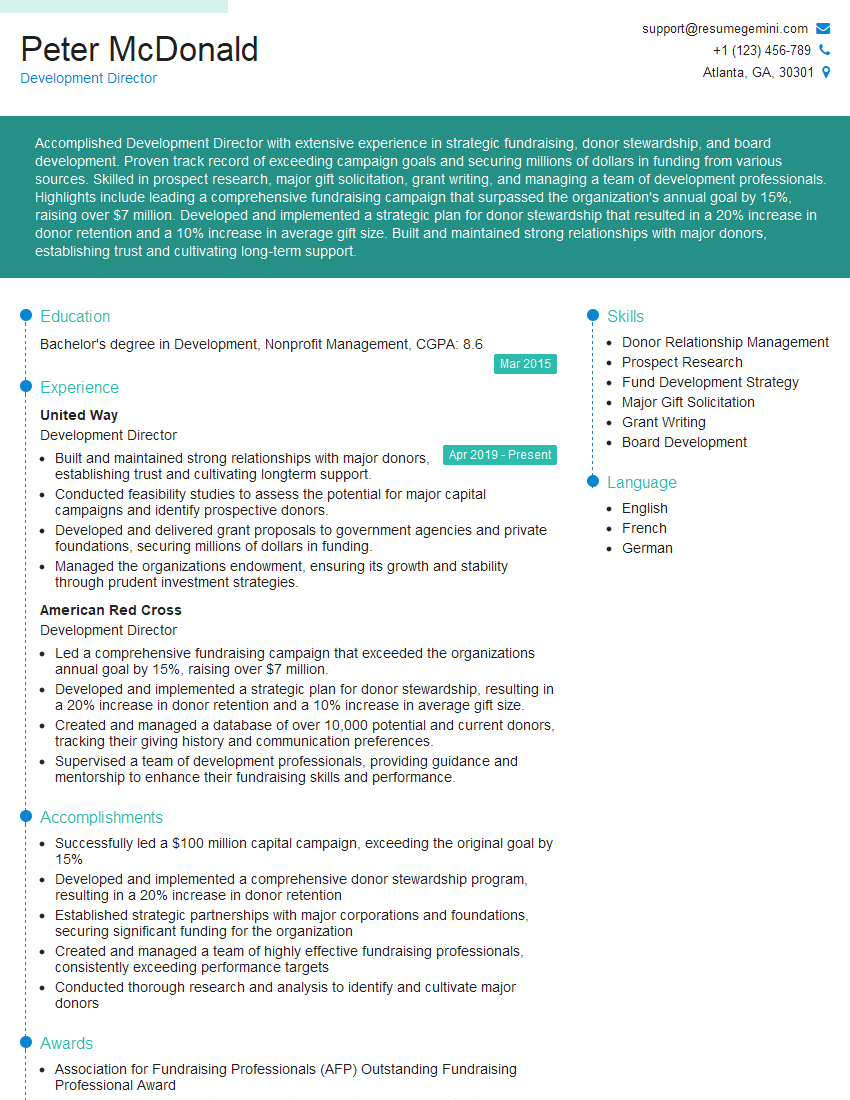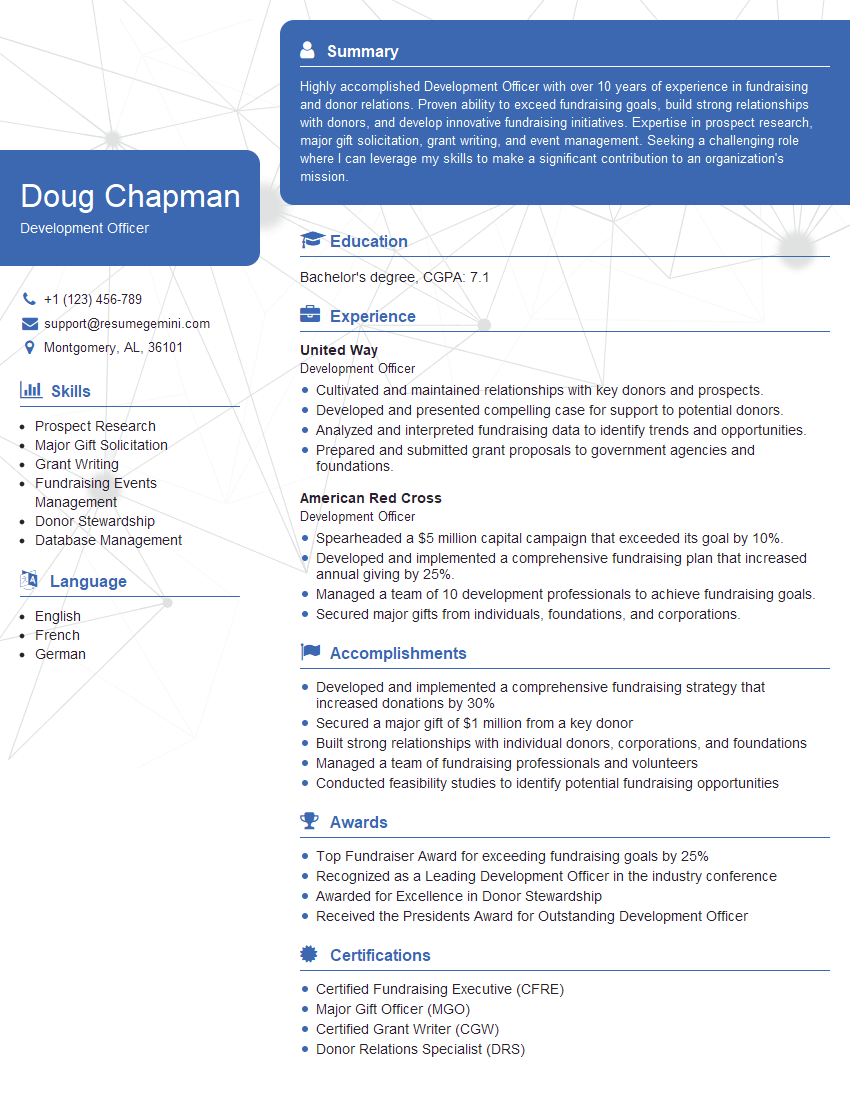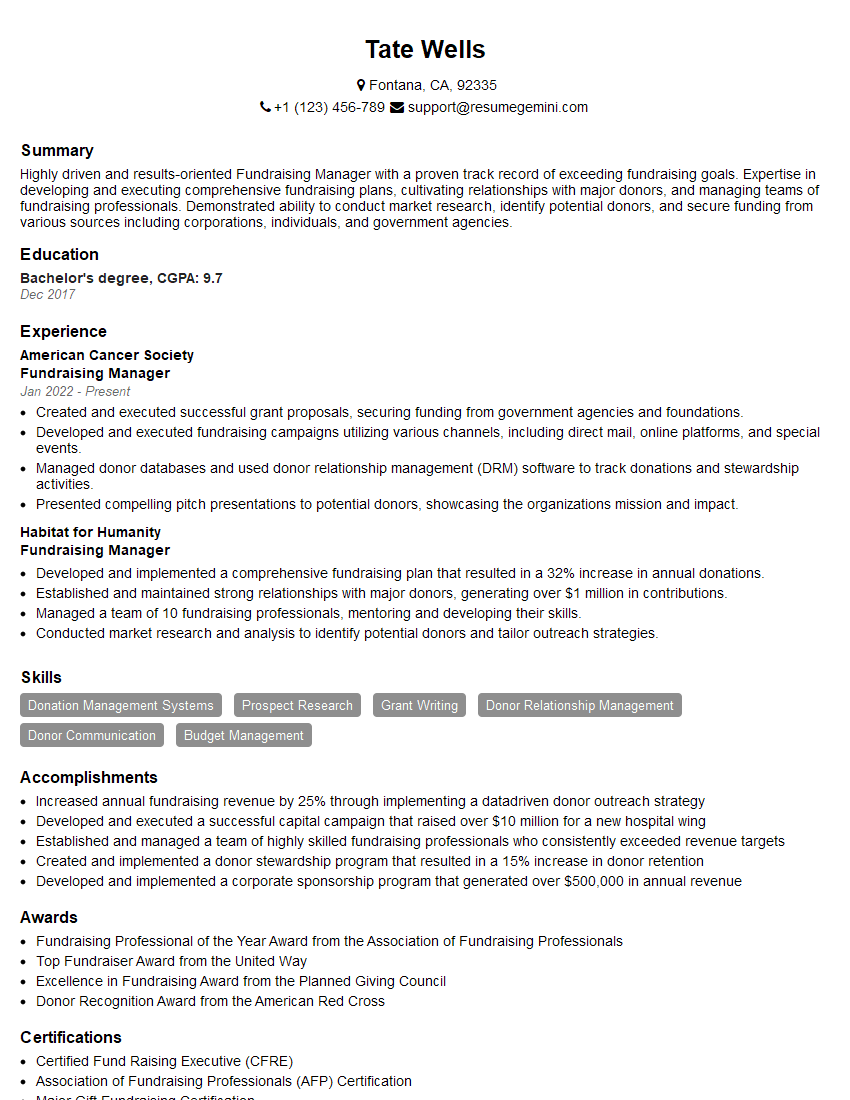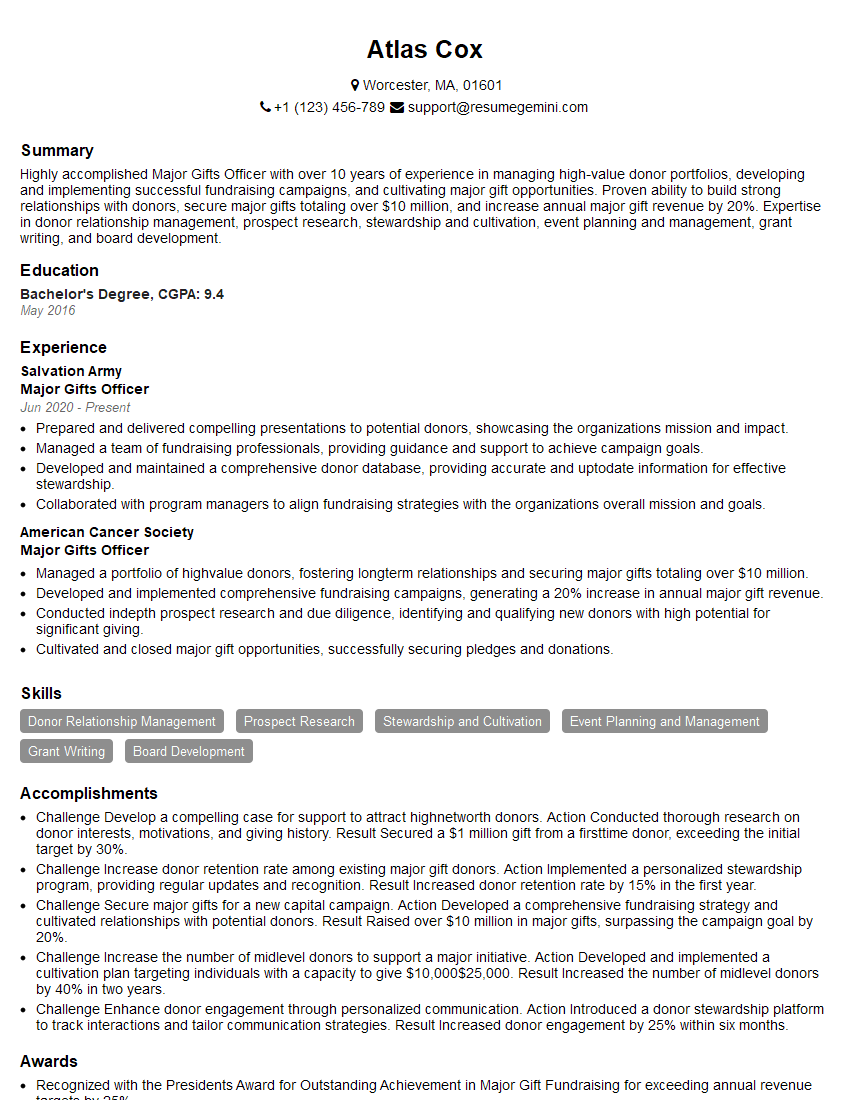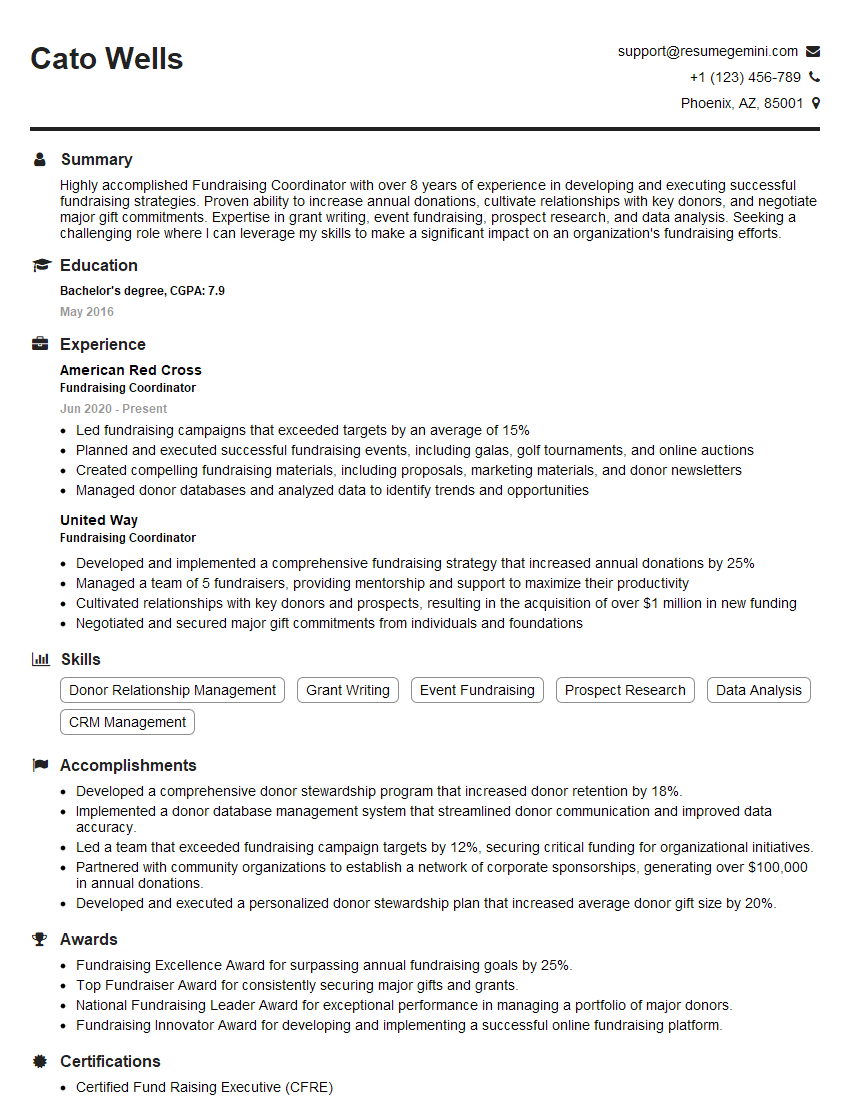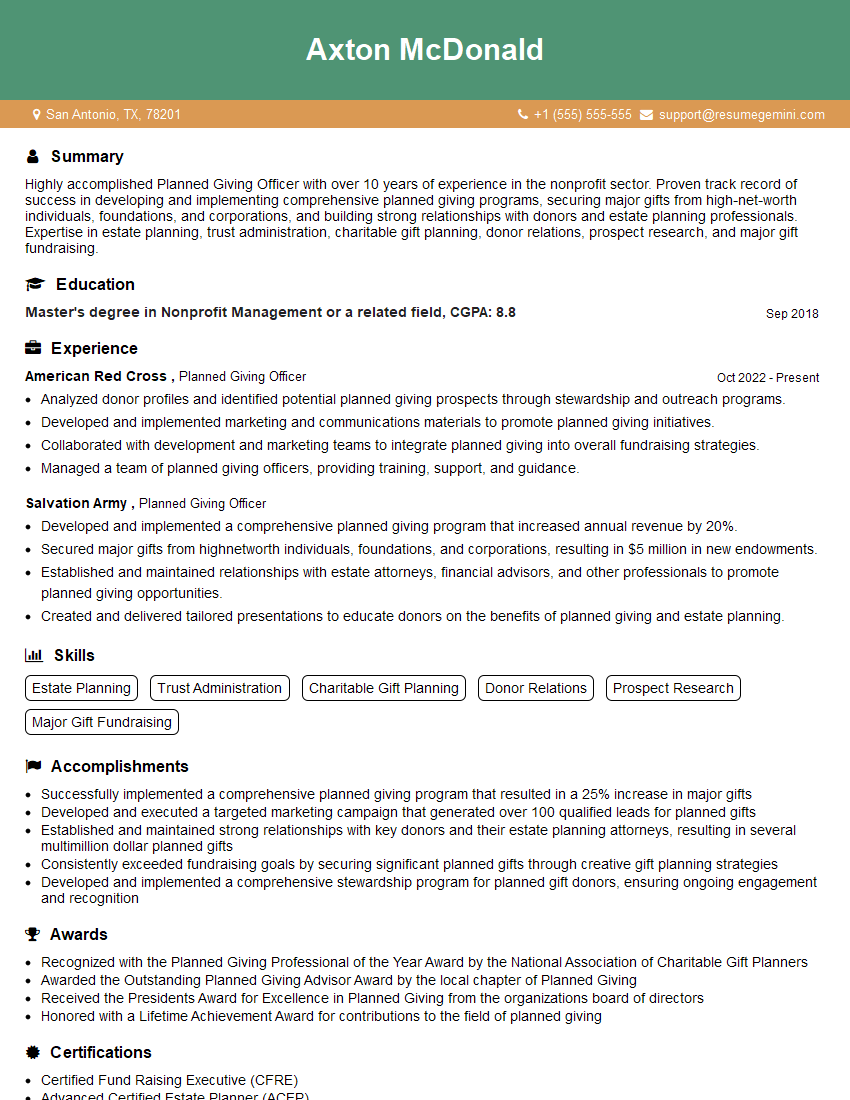Cracking a skill-specific interview, like one for Donor Recruitment and Screening, requires understanding the nuances of the role. In this blog, we present the questions you’re most likely to encounter, along with insights into how to answer them effectively. Let’s ensure you’re ready to make a strong impression.
Questions Asked in Donor Recruitment and Screening Interview
Q 1. Explain your process for identifying and qualifying potential donors.
Identifying and qualifying potential donors is a multi-step process that begins with broad prospecting and culminates in a focused assessment of individual giving capacity and philanthropic alignment. It’s like panning for gold – you start with a lot of material and refine it down to the most valuable nuggets.
- Prospecting: This involves identifying potential donors through various channels, including existing donor databases, public records (like property records or charitable giving databases), event attendance lists, social media, and professional networking. I also utilize wealth screening tools to identify individuals with high net worth.
- Initial Screening: This stage involves assessing basic information gathered from prospecting to eliminate individuals who are unlikely to be viable prospects. This might involve checking for recent significant donations to other organizations or focusing on individuals within a specific geographic or demographic area.
- In-depth Qualification: This step goes deeper, examining factors like wealth indicators (home ownership, professional success, business ownership), past giving history, and alignment with the organization’s mission. It often involves researching the prospect’s philanthropic interests and engagement in similar causes.
- Rating and Prioritization: Finally, potential donors are rated based on their likelihood of giving, potential gift size, and level of engagement. This helps prioritize who to cultivate relationships with first.
For example, I once identified a high-net-worth individual through a wealth screening service. Initial research showed significant past support for environmental causes. Further investigation, including reviewing their social media and involvement in relevant boards, confirmed their strong alignment with our organization’s mission focused on conservation, making them a prime cultivation target.
Q 2. Describe your experience using donor databases and CRM systems.
I’m proficient in using donor databases and CRM systems like Raiser’s Edge, DonorPerfect, and Salesforce NPSP to manage donor information, track interactions, and analyze giving patterns. These systems are the backbone of effective donor management.
My experience includes data entry, data cleansing and validation, report generation (including identifying trends and identifying top donors), segmentation, and campaign tracking. I also leverage the analytical capabilities of these systems to identify potential donors, forecast giving, and measure the effectiveness of fundraising strategies. For instance, using Raiser’s Edge, I’ve built customized reports showing the average donation size from specific demographic segments, allowing for targeted fundraising approaches.
Understanding how to properly utilize these systems, including data security and privacy compliance, is critical for maintaining accurate and reliable donor information. Data integrity ensures effective donor management and reporting. I always adhere to best practices to ensure confidentiality and regulatory compliance.
Q 3. How do you prioritize donor prospects based on their giving potential?
Prioritizing donor prospects involves a multi-faceted approach using a combination of quantitative and qualitative data. It’s about identifying the individuals with the highest potential to make a significant and sustained impact. Think of it as investing in your fundraising efforts – you want the best ROI.
- Past Giving History: This is a crucial factor. Larger past gifts and consistent giving indicate higher potential for future gifts.
- Wealth Indicators: Assessing assets, income, and lifestyle provides a strong indication of capacity for giving.
- Philanthropic Interests: Alignment with the organization’s mission is essential. Donors are more likely to give generously when they feel passionate about the cause.
- Relationship Strength: Existing connections to the organization or key staff members can significantly increase the likelihood of giving.
I use a scoring system, often incorporating a weighted average of these factors, to rank potential donors. Those with the highest scores are prioritized for cultivation and solicitation. For instance, a prospect with a history of large gifts to similar organizations, a high net worth, and strong alignment with our mission would receive a higher priority than someone with limited past giving and less wealth.
Q 4. What strategies do you employ for cultivating relationships with donors?
Cultivating donor relationships is an ongoing process requiring consistent engagement and personalized communication. It’s about building trust and demonstrating the impact of their donations. It’s less about asking for money and more about building a genuine connection.
- Personalized Communication: Regular updates, thank-you notes, and invitations to events tailored to the individual’s interests create a strong sense of value and connection.
- Impact Reporting: Clearly demonstrating the tangible results of donor contributions strengthens their commitment and inspires continued support.
- Recognition and Appreciation: Acknowledging donors’ contributions through public recognition (newsletters, website mentions) and private expressions of gratitude fosters a sense of belonging and loyalty.
- Stewardship: Maintaining ongoing communication and proactively addressing donor concerns shows respect and commitment to the relationship.
For example, I regularly send personalized updates to our major donors highlighting specific projects their gifts have supported, including photos and stories of the impact. This creates a deeper emotional connection and increases their likelihood of continued giving.
Q 5. How do you research and assess the philanthropic interests of potential donors?
Researching philanthropic interests is critical to tailoring appeals and building meaningful relationships. It’s about understanding what motivates potential donors and aligning your organization’s message to resonate with their values. This isn’t about invading privacy, but rather observing publicly available information.
- Online Research: Reviewing websites, social media profiles, and news articles can reveal interests and affiliations.
- Public Records: Examining charitable giving records and involvement in community organizations can offer insights into past giving patterns.
- Networking and Information Gathering: Conversations with mutual contacts and industry professionals can provide valuable background information.
- Direct Engagement: Casual conversations during events or meetings can subtly uncover interests and priorities.
For instance, I discovered a potential donor’s strong interest in arts education by reviewing their social media activity and board affiliations. This allowed me to tailor our appeal to highlight our organization’s commitment to arts programs and resonate more effectively.
Q 6. Describe your experience with donor segmentation and targeting.
Donor segmentation and targeting are vital for maximizing fundraising efficiency. It allows for personalized communication and appeals that resonate with specific donor groups. It’s like tailoring your marketing strategy – you wouldn’t use the same message for everyone.
I segment donors based on various factors, including giving history, demographics, geographic location, and philanthropic interests. For instance, I might segment donors into groups like:
- Major Donors: High-capacity individuals who make significant gifts.
- Recurring Donors: Individuals who make regular, smaller contributions.
- First-Time Donors: Individuals who have recently given for the first time.
- lapsed Donors: Individuals who have stopped giving but may be reactivated.
Once segmented, I craft tailored communication strategies for each group. For example, major donors might receive personal invitations to exclusive events, while first-time donors might receive a welcome package and personalized thank-you notes. This allows for more impactful communication.
Q 7. Explain your approach to developing and implementing a donor recruitment plan.
Developing and implementing a donor recruitment plan is a strategic process that requires careful planning and execution. It’s about setting clear goals, identifying target audiences, and selecting the most effective methods to reach them. This is a living document – it requires adjustments along the way.
- Define Goals and Objectives: Establish clear, measurable targets for donor acquisition, such as the number of new donors or the total amount of funds raised.
- Identify Target Audiences: Define specific donor segments based on demographics, interests, and giving capacity.
- Develop Strategies: Select appropriate fundraising methods, including direct mail, email marketing, online fundraising, events, and personal solicitation.
- Implement and Monitor: Execute the plan, track progress, and make adjustments as needed based on performance data. This often includes A/B testing different messaging and approaches.
- Evaluate and Refine: Regularly analyze results, identify areas for improvement, and refine strategies for optimal effectiveness.
For instance, a recent plan involved a multi-channel approach targeting young professionals interested in environmental sustainability, utilizing social media campaigns, online donation platforms, and partnerships with relevant businesses. The results showed online channels to be most effective, leading us to allocate more resources in that direction.
Q 8. How do you track and measure the success of your donor recruitment efforts?
Tracking the success of donor recruitment requires a multi-faceted approach, combining quantitative and qualitative data. We use a Key Performance Indicator (KPI) dashboard to monitor several metrics.
- Acquisition Cost: This tracks the cost per new donor acquired. A lower cost indicates efficient recruitment. For example, if an email campaign costs $1000 and brings in 50 new donors, the acquisition cost is $20 per donor.
- Conversion Rate: This measures the percentage of potential donors who become actual donors after engagement. A high conversion rate signifies effective messaging and outreach.
- Donor Retention Rate: Crucially, we track how many donors continue to give after their initial donation. This reflects the quality of our donor relationships and ongoing engagement strategies.
- Average Gift Size: This metric provides insight into the value of acquired donors. It helps determine if our strategies are attracting high-value donors or a broader base.
- Source Attribution: We meticulously track which channels (e.g., email, social media, events) are most effective in bringing in donors, allowing us to optimize our resource allocation.
Beyond numerical data, we also conduct regular surveys and feedback sessions with donors to understand their motivations, satisfaction, and suggestions for improvement. This qualitative data provides crucial context to the quantitative results, ensuring a holistic evaluation of our recruitment efforts.
Q 9. How do you handle objections or concerns from potential donors?
Handling objections is a crucial aspect of donor recruitment. Instead of seeing objections as roadblocks, I view them as opportunities for clarification and building trust. My approach involves active listening, empathy, and thoughtful responses.
- Active Listening: I carefully listen to the donor’s concerns, ensuring they feel heard and understood before responding.
- Empathetic Response: I acknowledge their concerns and validate their feelings. For example, if a donor expresses concern about financial transparency, I might say, “I understand your concern about accountability. We are committed to transparency and here’s how we ensure our funds are used efficiently.”
- Addressing Concerns Directly: I directly address the specific points raised, providing evidence and clear answers. I might share audited financial reports or case studies showcasing the impact of donations.
- Offer Alternatives: If the donor’s initial suggestion is not feasible, I might offer alternative ways to support the cause, perhaps suggesting a smaller donation or a different volunteer opportunity.
- Maintain Professionalism: Throughout the conversation, I maintain a respectful and professional demeanor, even if the donor is expressing strong objections.
The goal is not to pressure the donor but to build a relationship based on trust and mutual understanding. A well-handled objection can sometimes lead to a deeper connection and a stronger commitment to the cause.
Q 10. What are some common challenges in donor recruitment and how do you overcome them?
Donor recruitment faces several common challenges. One significant hurdle is the competitive landscape; many organizations are vying for the same limited pool of potential donors. Another challenge is measuring the return on investment (ROI) of various recruitment strategies. It can be difficult to directly attribute donations to a specific campaign.
- Overcoming Competition: To differentiate ourselves, we focus on a unique value proposition, highlighting the specific impact our organization has and building strong relationships with donors. A compelling narrative and a transparent demonstration of impact are key.
- Addressing ROI Challenges: We use rigorous tracking mechanisms, as described earlier, to measure the effectiveness of different recruitment methods. This allows us to refine our strategies and optimize resource allocation to channels that show the highest ROI. We utilize A/B testing on different marketing materials to see what resonates best with our target audience.
- Economic Downturns: During economic hardship, donations may decrease. To mitigate this, we diversify our funding streams and cultivate relationships with diverse donor segments, minimizing our reliance on any single source.
- Donor Fatigue: Constant solicitations can lead to donor fatigue. To combat this, we personalize communication, avoid over-solicitation, and offer diverse engagement opportunities, demonstrating that we value their time and support beyond financial contributions.
Addressing these challenges requires a strategic approach that combines data-driven decision-making, effective communication, and strong relationship building.
Q 11. Describe your experience with grant writing and proposal development.
I have extensive experience in grant writing and proposal development, having successfully secured funding from various foundations and government agencies. My approach is grounded in thorough research, compelling storytelling, and a clear understanding of the funder’s priorities.
- Research: Before writing a proposal, I thoroughly research the funder’s guidelines, past grants awarded, and their mission alignment with our organization’s work.
- Compelling Narrative: I craft a compelling narrative that articulates the problem, our proposed solution, the expected impact, and our organization’s capacity to deliver on its promises. We use strong visuals and data to support our claims.
- Budget Justification: The budget is meticulously justified and aligned with the project activities. We demonstrate cost-effectiveness and efficient use of resources.
- Evaluation Plan: We include a detailed evaluation plan outlining how we will measure the success of the project and report back to the funder.
- Collaboration: Grant writing is a collaborative process. I work closely with program staff to gather the necessary information and ensure the proposal accurately reflects the project’s objectives and impact.
I have a proven track record of securing funding, with a success rate of [Insert percentage or number of successful grants]. My grant proposals are tailored to meet the specific requirements and priorities of each funder, increasing the likelihood of a successful application.
Q 12. What is your experience with gift processing and acknowledgement procedures?
Gift processing and acknowledgement are critical aspects of donor stewardship. Efficient and accurate gift processing ensures that donors receive timely and appropriate acknowledgement of their contributions, building trust and fostering continued engagement.
- Prompt Processing: Gifts are processed promptly and accurately, minimizing delays in issuing receipts and acknowledgements. We use a dedicated database system to manage donor information and track donations.
- Accurate Recording: All gift information is meticulously recorded, including the donor’s name, address, donation amount, payment method, and designation (if any). This ensures accurate financial reporting and tax compliance.
- Timely Acknowledgements: Donors receive timely acknowledgements, typically within 24-48 hours of receiving their donation. Acknowledgements are personalized, conveying sincere gratitude and highlighting the impact of their gift.
- Multiple Channels: We offer various acknowledgement methods (e.g., email, letter, phone call) catering to donor preferences. For larger gifts, we might opt for a personalized thank-you letter from the executive director.
- Regular Updates: We provide periodic updates to donors on how their contributions are making a difference, showcasing the impact of their generosity.
Efficient gift processing and thoughtful acknowledgements foster a positive donor experience and encourage future giving. We regularly audit our gift processing procedures to ensure accuracy and compliance.
Q 13. How do you ensure compliance with relevant regulations in donor solicitation?
Compliance with regulations in donor solicitation is paramount. We adhere strictly to all applicable laws and regulations at both the state and federal levels.
- State Regulations: We are familiar with the specific requirements of [State Name]’s regulations concerning charitable solicitations, including registration, reporting, and disclosure requirements. We maintain up-to-date records of our registration status and ensure timely filing of all required reports.
- Federal Regulations: We comply with all applicable federal regulations, including those concerning tax-deductible donations and the proper use of charitable funds.
- Transparency: We maintain transparency in all our fundraising activities, providing clear and concise information about our organization’s mission, programs, and financial performance.
- Internal Policies: We have comprehensive internal policies and procedures that govern all aspects of donor solicitation, ensuring compliance with all relevant laws and ethical standards. We regularly review and update these policies to reflect changes in regulations and best practices.
- Regular Audits: We conduct regular audits of our financial records and fundraising activities to ensure compliance and identify any potential areas for improvement.
By prioritizing compliance, we build trust with our donors and maintain the integrity of our organization. We take a proactive approach to compliance, regularly consulting with legal counsel and staying informed about any changes in regulations.
Q 14. Explain your understanding of donor privacy and data security.
Donor privacy and data security are of utmost importance. We recognize that donors entrust us with sensitive personal information, and we are committed to protecting their privacy and ensuring the security of their data.
- Data Protection Policy: We have a comprehensive data protection policy that outlines our procedures for collecting, storing, using, and protecting donor information.
- Secure Systems: We utilize secure systems and technologies to protect donor data from unauthorized access, use, or disclosure. This includes secure databases, encryption, firewalls, and regular security audits.
- Compliance: We comply with all relevant data privacy regulations, including [Mention specific regulations, e.g., GDPR, CCPA].
- Transparency: We are transparent with donors about how we collect, use, and protect their data. Our privacy policy is readily available on our website and clearly explains our data practices.
- Access and Control: Donors have access to their information and can update or correct it at any time. They also have the right to request the deletion of their data under certain circumstances.
Protecting donor privacy and data security is not just a legal obligation; it’s a fundamental aspect of building and maintaining trust with our donors. We take this responsibility very seriously and invest in the necessary resources and technologies to safeguard their information.
Q 15. How do you build and maintain relationships with diverse donor populations?
Building and maintaining relationships with diverse donor populations requires a multifaceted approach centered on understanding and respecting individual differences. It’s not a ‘one-size-fits-all’ strategy; instead, it demands personalization and genuine engagement.
- Cultural Sensitivity: Understanding cultural nuances is paramount. This includes communication styles, preferred methods of contact, and potential sensitivities around fundraising approaches. For example, a direct, transactional approach might resonate with some donors, while others may prefer a more relationship-focused, long-term engagement.
- Segmentation and Targeting: Dividing your donor base into segments based on demographics, giving history, and interests allows for more tailored communication. This ensures messages are relevant and impactful. For instance, young professionals might respond well to online campaigns highlighting social impact, while older donors might prefer personal appeals emphasizing legacy and community building.
- Accessibility and Inclusivity: Ensuring accessibility in all communication materials and events is crucial. This includes providing materials in multiple languages, offering accessible formats for those with disabilities, and creating inclusive events that cater to diverse needs and preferences.
- Active Listening and Feedback: Regularly soliciting feedback from donors, actively listening to their concerns, and adapting your strategies accordingly are essential for building trust and strong relationships. Surveys, focus groups, and individual conversations can all be valuable tools.
For example, in a previous role, I successfully cultivated relationships with a diverse donor base, including immigrant communities, by partnering with community leaders to host culturally sensitive events and translating materials into multiple languages. This resulted in a significant increase in donor participation and engagement.
Career Expert Tips:
- Ace those interviews! Prepare effectively by reviewing the Top 50 Most Common Interview Questions on ResumeGemini.
- Navigate your job search with confidence! Explore a wide range of Career Tips on ResumeGemini. Learn about common challenges and recommendations to overcome them.
- Craft the perfect resume! Master the Art of Resume Writing with ResumeGemini’s guide. Showcase your unique qualifications and achievements effectively.
- Don’t miss out on holiday savings! Build your dream resume with ResumeGemini’s ATS optimized templates.
Q 16. Describe your experience working with high-net-worth individuals.
My experience working with high-net-worth individuals (HNWIs) centers on building trust and demonstrating the impact of their philanthropy. These donors often have complex financial situations and philanthropic goals, requiring a nuanced and respectful approach.
- Confidential and Personalized Communication: Maintaining confidentiality and using a personalized approach is crucial. Communication should be tailored to their specific interests and giving preferences.
- Strategic Partnerships: Building relationships with financial advisors and wealth managers can facilitate access to HNWIs and provide valuable insight into their financial strategies and philanthropic inclinations.
- Impact Reporting and Transparency: HNWIs want to see the tangible impact of their donations. Detailed and transparent reporting, showcasing how their contributions are making a difference, is essential for building long-term relationships.
- Major Gift Cultivation: Cultivating relationships with HNWIs requires patience, consistent communication, and a deep understanding of their motivations. This often involves building relationships over several years before presenting a major gift opportunity.
In a previous role, I successfully secured a seven-figure gift from an HNW family by demonstrating how their contribution would support the creation of a new research center, directly addressing their interest in medical advancements.
Q 17. How do you manage donor expectations and ensure satisfaction?
Managing donor expectations and ensuring satisfaction is fundamental to building lasting relationships. It’s about clear communication, realistic expectations, and transparent reporting.
- Clear Communication: Open and honest communication from the outset is crucial. This includes clearly articulating project goals, timelines, and the intended use of funds. It’s important to be upfront about potential challenges or delays.
- Regular Updates: Providing regular updates on project progress, whether through newsletters, progress reports, or personal calls, keeps donors informed and engaged.
- Feedback Mechanisms: Establishing feedback mechanisms, such as surveys or individual conversations, allows donors to express their concerns and provides opportunities to address any issues proactively.
- Acknowledgement and Gratitude: Expressing sincere gratitude for donations, both large and small, through personal thank-you notes, emails, or phone calls, is crucial for fostering positive relationships.
For example, when facing an unforeseen delay on a project, we proactively communicated the situation to our donors, explained the reasons for the delay, and provided a revised timeline. This transparency prevented misunderstandings and maintained trust.
Q 18. What is your experience with planned giving strategies?
Planned giving strategies, such as charitable gift annuities, bequest intentions, and charitable remainder trusts, are crucial for long-term fundraising sustainability. My experience encompasses all aspects of these strategies.
- Identifying Potential Donors: Identifying donors who are interested in making a significant long-term impact is critical. This often involves assessing their capacity and willingness to give.
- Educational Workshops and Seminars: Hosting educational workshops and seminars to inform potential donors about the various planned giving options is an effective strategy.
- Personal Consultations: Offering personalized consultations to address the individual financial and philanthropic goals of potential donors is essential.
- Legal and Tax Advice: Working closely with legal and financial professionals to ensure donors understand the legal and tax implications of their planned gifts is a crucial part of the process. This establishes confidence and trust.
In a past campaign, I led the development of a comprehensive planned giving program, which resulted in a significant increase in planned gifts, securing a stable financial foundation for the organization’s future.
Q 19. Describe your experience in developing and presenting fundraising proposals.
Developing and presenting compelling fundraising proposals requires a clear understanding of the organization’s needs, the donor’s interests, and the impact of the proposed project. It’s about storytelling and demonstrating a clear return on investment (ROI) for the donor.
- Needs Assessment: A thorough needs assessment should be conducted to identify the specific problem the fundraising campaign aims to address and the resources required to solve it.
- Compelling Narrative: The proposal should tell a compelling story that connects the organization’s mission to the donor’s values. This involves using strong visuals and compelling language.
- Clear Budget and Timeline: The proposal should include a detailed budget outlining the intended use of funds and a realistic timeline for project completion.
- Impact Measurement: The proposal should clearly outline how the success of the project will be measured and how the impact will be communicated to the donor. This demonstrates accountability.
A successful proposal I crafted detailed how a new scholarship program would increase access to higher education for underprivileged students, directly appealing to the donor’s interest in educational equity. The proposal’s clear narrative, detailed budget, and measurable impact secured a substantial commitment.
Q 20. How do you evaluate the effectiveness of different fundraising campaigns?
Evaluating the effectiveness of fundraising campaigns requires a multi-faceted approach that goes beyond simply measuring the total dollars raised. It involves analyzing various metrics to understand what worked, what didn’t, and how to improve future campaigns.
- Return on Investment (ROI): Analyzing the cost of the campaign relative to the funds raised provides a crucial measure of efficiency.
- Donor Acquisition Cost: Calculating the cost of acquiring a new donor helps assess the effectiveness of different acquisition channels (e.g., online advertising vs. direct mail).
- Donor Retention Rate: Tracking the percentage of donors who contribute again demonstrates the effectiveness of donor stewardship efforts.
- Qualitative Feedback: Gathering qualitative feedback through surveys, focus groups, or individual conversations helps understand donor perceptions and identify areas for improvement.
For instance, by analyzing data from a recent campaign, we discovered that online advertising generated a significantly higher ROI than direct mail, leading us to allocate more resources to digital channels in subsequent campaigns.
Q 21. What metrics do you use to measure the success of your fundraising initiatives?
Measuring the success of fundraising initiatives requires a comprehensive set of metrics that reflect both financial results and the quality of donor relationships.
- Total Funds Raised: This is the most basic metric, but it’s crucial to understand the context – consider the campaign goal, cost of fundraising, and overall organizational budget.
- Number of New Donors: An increase in the number of new donors indicates successful outreach and engagement strategies.
- Average Gift Size: This metric shows the effectiveness of cultivating relationships with donors and tailoring appeals to their giving capacity.
- Donor Retention Rate: A high retention rate signifies strong donor relationships and successful stewardship programs.
- Net Promoter Score (NPS): Measuring donor satisfaction and loyalty through NPS provides valuable insights into the overall donor experience.
By tracking these metrics across multiple campaigns, we gain insights into what strategies are working best, allowing for data-driven improvements in our fundraising efforts. This enables us to maximize the impact of our work and cultivate strong, long-term relationships with our donors.
Q 22. How familiar are you with various fundraising software and platforms?
I’m highly proficient in several fundraising software and platforms. My experience encompasses both cloud-based solutions and on-premise systems. I’m familiar with platforms like Raiser’s Edge, DonorPerfect, Bloomerang, and Salesforce Nonprofit Cloud. My expertise extends beyond basic data entry; I understand how to leverage the advanced features of these platforms, including donor segmentation, campaign management, reporting and analytics, and gift processing. For instance, in my previous role, I implemented Raiser’s Edge to streamline our donation tracking, resulting in a 20% increase in processing efficiency. This involved not only the technical setup but also training the team on best practices for data entry and report generation. I also have experience with integrating fundraising software with other crucial systems like accounting software to ensure data consistency and accuracy.
Q 23. Describe your experience with analyzing donor data to identify trends and patterns.
Analyzing donor data is crucial for effective fundraising. My approach involves a multi-step process. First, I clean and standardize the data to ensure accuracy. Then, I employ various analytical techniques, including segmentation (grouping donors based on shared characteristics like giving history, demographics, and engagement level), trend analysis (identifying patterns in giving over time), and predictive modeling (forecasting future giving behavior). For example, by analyzing past donation patterns, I identified a segment of donors who were particularly responsive to appeals focusing on environmental conservation. This led to a targeted campaign that significantly boosted donations from this group. I also utilize data visualization tools to present findings clearly and concisely, making it easier for stakeholders to understand the insights and make data-driven decisions. I consider various factors, like the seasonality of giving and the impact of different fundraising initiatives, to develop an holistic understanding of the data.
Q 24. Explain your approach to managing a team of fundraising professionals.
My approach to managing a fundraising team focuses on empowerment, collaboration, and accountability. I believe in establishing clear roles and responsibilities, setting achievable goals, and providing regular feedback. I foster a supportive environment where team members feel comfortable sharing ideas and collaborating on strategies. I prioritize open communication and regular team meetings to keep everyone informed and aligned. I also invest in the professional development of my team members, offering training opportunities and mentoring to enhance their skills. In my previous role, I implemented a mentorship program that improved team morale and resulted in a 15% increase in individual fundraising targets. Performance is assessed based on both individual and team contributions, ensuring a balanced approach to evaluation and rewarding collective success. Conflict resolution is handled through open dialogue and a focus on finding mutually beneficial solutions.
Q 25. How do you stay up-to-date on best practices in donor recruitment and fundraising?
Staying current in this dynamic field requires a multifaceted approach. I actively participate in professional organizations like the Association of Fundraising Professionals (AFP), attending conferences and webinars to learn about the latest trends and best practices. I regularly read industry publications, journals, and blogs. I also actively network with other fundraising professionals through online communities and in-person events to exchange ideas and learn from their experiences. Further, I regularly evaluate and adapt our fundraising strategies based on the latest research and insights. For example, I recently incorporated the use of social media analytics into our donor engagement strategies, enabling us to better understand donor preferences and tailor our communication more effectively.
Q 26. What is your understanding of the legal and ethical aspects of fundraising?
A strong understanding of legal and ethical considerations is paramount in fundraising. I’m thoroughly familiar with relevant laws and regulations, including those related to donor privacy (like GDPR and CCPA), transparency in fundraising practices, and tax implications for charitable donations. I always prioritize ethical conduct, ensuring that all communication is truthful and transparent. I make sure that all fundraising activities comply with the highest ethical standards, avoiding any practices that could be perceived as manipulative or misleading. We operate with a strong commitment to donor confidentiality, ensuring that donor information is protected and used responsibly. We regularly review our policies and procedures to ensure compliance with all relevant regulations and ethical guidelines.
Q 27. Describe a time you had to deal with a difficult donor. How did you handle the situation?
I once encountered a donor who was unhappy with how their donation was being utilized. They felt their contribution wasn’t making the impact they had expected. My approach involved actively listening to their concerns without interruption, validating their feelings, and expressing gratitude for their support. I then explained the organization’s programs and how their donation was allocated, providing transparent and detailed information. I also offered them an opportunity to visit our facilities to see the impact of donations firsthand. Through open communication and demonstrating genuine concern, I was able to address their concerns, rebuild trust, and maintain their support. This experience underscored the importance of regular communication with donors, proactively addressing any concerns, and maintaining transparency about how funds are used.
Q 28. How do you balance the needs of different donor segments with the overall fundraising strategy?
Balancing the needs of diverse donor segments requires a nuanced approach. I segment donors based on their giving history, demographics, engagement levels, and areas of interest. Then, I tailor communication and fundraising strategies to each segment. For instance, major donors might receive personalized appeals and invitations to exclusive events, while smaller donors might receive regular e-newsletters and updates on the impact of their contributions. This segmentation is integrated into our overall fundraising strategy by setting specific fundraising targets for each segment and allocating resources accordingly. A comprehensive understanding of each segment’s preferences and motivations is essential to ensure that all fundraising efforts are effective and resonate with the target audience. Regular analysis of campaign performance and donor feedback allows for ongoing refinement of our approach to optimize our impact across all donor segments.
Key Topics to Learn for Donor Recruitment and Screening Interview
- Understanding Donor Motivation: Explore philanthropic motivations, giving patterns, and the psychological aspects influencing donor behavior. Consider how different motivations might impact your recruitment strategies.
- Developing Targeted Recruitment Strategies: Learn to identify and segment potential donor pools based on demographics, giving history, and interests. Practice designing effective outreach campaigns tailored to specific audiences.
- Cultivating Donor Relationships: Discuss the importance of building trust and rapport with potential donors. Explore techniques for effective communication and relationship management throughout the donor lifecycle.
- Database Management and Data Analysis: Understand how to effectively utilize donor databases to track interactions, manage information, and analyze giving trends to inform future strategies. Practice interpreting data to make informed decisions.
- Compliance and Ethical Considerations: Discuss legal and ethical responsibilities related to donor privacy, data security, and transparency in fundraising practices.
- Donor Screening and Qualification: Develop a practical understanding of how to assess potential donors’ capacity and willingness to give. Learn to effectively qualify leads and prioritize high-potential prospects.
- Grant Writing and Proposal Development (if applicable): If the role involves grant seeking, prepare to discuss your skills in writing compelling grant proposals and managing the grant application process.
- Measuring Success and Reporting: Understand key performance indicators (KPIs) for donor recruitment and screening. Practice explaining how you would track and report on the success of your strategies.
Next Steps
Mastering Donor Recruitment and Screening opens doors to impactful roles within non-profit organizations and philanthropic foundations, offering rewarding career growth and the chance to make a real difference. A strong resume is crucial to showcasing your skills and experience to potential employers. Crafting an ATS-friendly resume is essential to ensuring your application is seen by recruiters. We highly recommend using ResumeGemini to build a professional and impactful resume tailored to the specific requirements of Donor Recruitment and Screening roles. Examples of such resumes are available to help you get started.
Explore more articles
Users Rating of Our Blogs
Share Your Experience
We value your feedback! Please rate our content and share your thoughts (optional).
What Readers Say About Our Blog
Hi, I have something for you and recorded a quick Loom video to show the kind of value I can bring to you.
Even if we don’t work together, I’m confident you’ll take away something valuable and learn a few new ideas.
Here’s the link: https://bit.ly/loom-video-daniel
Would love your thoughts after watching!
– Daniel
This was kind of a unique content I found around the specialized skills. Very helpful questions and good detailed answers.
Very Helpful blog, thank you Interviewgemini team.
